Porifera Study guides, Class notes & Summaries
Looking for the best study guides, study notes and summaries about Porifera? On this page you'll find 172 study documents about Porifera.
Page 3 out of 172 results
Sort by
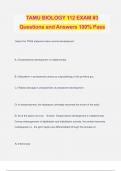
-
TAMU BIOLOGY 112 EXAM #3 Questions and Answers 100% Pass
- Exam (elaborations) • 33 pages • 2024
- Available in package deal
-
- $13.49
- + learn more
TAMU BIOLOGY 112 EXAM #3 Questions and Answers 100% Pass Select the TRUE statement about animal development: A.) Deuterostome development is indeterminate. B.) Mesoderm in protostomes arises as outpocketings of the primitive gut. C.) Radial cleavage is characteristic of protostome development. D) In deuterostomes, the blastopore ultimately becomes the mouth of the adult. E) All of the above are true. - Answer- Deuterostome development is indeterminate. During embryogenesis of diploblasti...
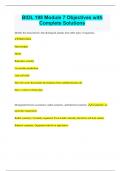
-
BIOL 198 Module 7 Objectives with Complete Solutions
- Exam (elaborations) • 33 pages • 2024
-
- $10.49
- + learn more
BIOL 198 Module 7 Objectives with Complete Solutions Identify the characteristics that distinguish animals from other types of organisms. Multicellular Heterotrophic Motile Reproduce sexually Use aerobic metabolism Lack cell walls Have life cycles that include development from undifferentiated cells Have a variety of body plans Distinguish between asymmetry, radial symmetry, and bilateral symmetry. Asymmetry: no particular organization Radial symmetry: Circularly organized...
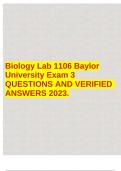
-
Biology Lab 1106 Baylor University Exam 3 QUESTIONS AND VERIFIED ANSWERS 2023.
- Exam (elaborations) • 4 pages • 2023
-
- $6.49
- + learn more
Biology Lab 1106 Baylor University Exam 3 QUESTIONS AND VERIFIED ANSWERS 2023. 1. Phylum Porifera (sponges): asymmetrical lack true tissues have unique cells called CHOANOCYTES (flagellated cells that will draw in water and filter food particles) Genus: Grantia, Spongia, Euplectella 2. Phylum Porifera Genus Grantia: isolated spicules walls of sponges contain amoebocytes and crystallized structures called spicules incurrent canals and flagellated canals 3. Phylum Porifera Genus Spon...
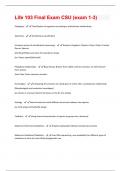
-
Life 103 Final Exam CSU (exam 1-3) Graded A Q&A Complete
- Exam (elaborations) • 15 pages • 2024
- Available in package deal
-
- $7.99
- + learn more
Phylogeny - Classification of organisms according to evolutionary relationships. Taxonomy - Evolutionary classification Linnaean system of classification (taxonomy) - Domain> Kingdom> Phylum> Class> Order> Family> Genus> Species (Did King Phillip Come Over For Grandma's Soup) [ex. Homo sapien](italicized) Phylogeny relationships - Basal Group: Branch from oldest common ancestor, no other branch from species. Sister Taxa: Share common ancestor Homologies - Comparing...
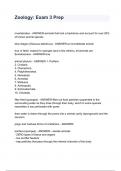
-
Zoology: Exam 3 Prep questions and answers
- Exam (elaborations) • 15 pages • 2024
-
- $7.99
- + learn more
invertebrates - ANSWER-animals that lack a backbone and account for over 95% of known animal species blue dragon (Glaucus atlanticus) - ANSWER-an invertebrate animal true or false: expect for sponges (and a few others), all animals are Eumetazoans - ANSWER-true animal phylum - ANSWER-1. Porifera 2. Cnidaria 3. Ctenophora 4. Platyhelminthes 5. Nematoda 6. Annelida 7. Mollusca 8. Arthropoda 9. Echinodermata 10. Chordata filter feed (sponges) - ANSWER-filter out food particles suspen...
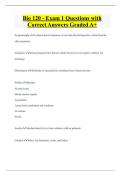
-
Bio 120 - Exam 1 Questions with Correct Answers Graded A+
- Exam (elaborations) • 39 pages • 2024
- Available in package deal
-
- $14.99
- + learn more
Bio 120 - Exam 1 Questions with Correct Answers Graded A+ Synapomorphy A shared derived character or trait state that distinguishes a clade from the other organisms. Analagous Having characteristics that are similar because of convergent evolution, not homology. Homologous Similarity in characteristics resulting from a shared ancestry. Porifera Sponges No true tissues Mostly marine, aquatic Asymmetric 2 germ layers (endoderm and ectoderm) No coelom Sessile
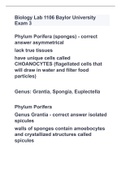
-
Biology Lab 1106 Baylor University Exam 3 with 100% correct answers
- Exam (elaborations) • 10 pages • 2023
-
- $12.99
- + learn more
Phylum Porifera (sponges) asymmetrical lack true tissues have unique cells called CHOANOCYTES (flagellated cells that will draw in water and filter food particles) Genus: Grantia, Spongia, Euplectella Phylum Porifera Genus Grantia isolated spicules walls of sponges contain amoebocytes and crystallized structures called spicules incurrent canals and flagellated canals 00:00 01:22 Phylum Porifera Genus Spongia have spongin fibers that are more flexible live spe...
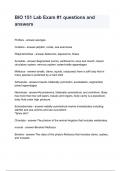
-
BIO 151 Lab Exam #1 questions and answers
- Exam (elaborations) • 5 pages • 2024
- Available in package deal
-
- $7.99
- + learn more
BIO 151 Lab Exam #1 questions and answers Porifera - answer-sponges Cnidaria - answer-jellyfish, corals, sea anemones Platyhelminthes - answer-flatworms, tapeworms, flukes Annelida - answer-Segmented worms, earthworms; anus and mouth; closed circulatory system; nervous system; setae-bristle appendages Mollusca - answer-(snails, clams, squids, octopuses) have a soft body that in many species is protected by a hard shell Arthopoda - answer-Insects: bilaterally symmetric; exoskeleton; segm...
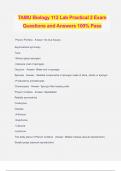
-
TAMU Biology 112 Lab Practical 2 Exam Questions and Answers 100% Pass
- Exam (elaborations) • 23 pages • 2024
- Available in package deal
-
- $13.49
- + learn more
TAMU Biology 112 Lab Practical 2 Exam Questions and Answers 100% Pass Phylum Porifera - Answer- No true tissues Asymmetrical symmetry Taxa: -Silicea (glass sponges) -Calcarea (rest of sponges) Osculum - Answer- Water exit in sponges Spicules - Answer- -Skeletal components of sponges made of silica, calcite or spongin -Produced by amoebocytes Choanocytes - Answer- Spong's filter-feeding cells Phylum Cnidaria - Answer- Diploblastic Radially symmetrical Cnidocytes Classes: -Anthozoa...
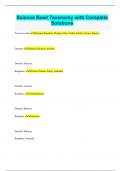
-
Science Bowl Taxonomy with Complete Solutions
- Exam (elaborations) • 4 pages • 2024
- Available in package deal
-
- $8.99
- + learn more
Science Bowl Taxonomy with Complete Solutions Taxons in order Domain, Kingdom, Phylum, Class, Order, Family, Genus, Species Domains Eukarya, Bacteria, Archaea Domain: Eukarya Kingdoms: Protista, Plantae, Fungi, Animalia Domain: Archaea Kingdom: Archaebacteria Domain: Bacteria Kingdom: Eubacteria Domain: Eukarya Kingdom: Animalia Phylum: Porifera, Cnidaria, Platyhelminthes, Nematoda, Annelida, Arthropoda, Mollusca, Echinodermata, Chordata Phylum: Species: Huma...

Did you know that on average a seller on Stuvia earns $82 per month selling study resources? Hmm, hint, hint. Discover all about earning on Stuvia


